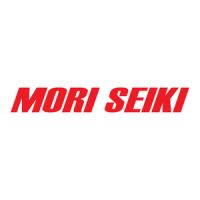2-292 MACHINE OPERATIONS OPERACIONES DE MECANIZADO
General start-up patterns are summarized below.
Cautions to be taken into consideration when creat-
ing a program are specified for the related tool paths.
A continuación se resumen los patrones generales de inicio.
Deberá tener precaución al crear un programa especificado
para las trayectorias de herramienta afines.
Chuck work (1) (Tool nose radius: 0.4 mm) Trabajo en plato (1) (radio de la nariz de la herramienta:
0,4 mm)
Chuck work (2) (Tool nose radius: 0.4 mm) Trabajo en plato (2) (radio de la nariz de la herramienta:
0,4 mm)
O1;
N1;
G50 S2000;
G00 T0101;
G96 S150 M03;
G42(G46) X50.0 Z3.0 M08; . . . . . .
G01 Z−30.0 F0.15;. . . . . . . . . . . . .
3
G00
G42 (G46)
50
φ
1
2
Start point
Punto de inicio
Programmed Point (at Start-Up)
Punto programado (en el comienzo)
At the end of this start-up block, the center of the tool nose is positioned
at a point which is at a right angle to the path to be generated by the
commands in the next block.
Al final de este bloque de comienzo el centro de la nariz de la
herramienta se posiciona en un punto que forma un ángulo recto con
la trayectoria que se va a generar mediante las instrucciones del
siguiente bloque.
Imaginary Tool Tip Position
Posición de la punta de la
herramienta imaginaria
Generally, at the start of a program, the pro-
grammed point and the imaginary tool tip posi-
tion are at the same position.
Generalmente, al principio de un programa
coinciden las posiciones del punto programado
y de la punta de la herramienta imaginaria.
Taking into account tool motion in the start-up block, allow a distance that is equal to, or larger than the tool nose radius
so that the cutting tool will not be hit against the workpiece.
Teniendo en cuenta el movimiento de la herramienta en el bloque de comienzo, deje una distancia igual o mayor que el
radio de la nariz de la herramienta, de modo que la herramienta de corte no golpee contra la pieza.
1
2
O1;
N1;
G50 S2000;
G00 T0101;
G96 S150 M03;
G42(G46) X50.0 Z20.0 M08; . . . . .
G01 Z3.0 F1.0;. . . . . . . . . . . . . . . .
Z−30.0 F0.15;
3 G01
G00
G42 (G46)
50
φ
1
2
Allow a distance that is equal to, or larger than the tool nose radius so that
the cutting tool will not be hit against the workpiece.
Deje una distancia igual o mayor que el radio de la nariz de la herramienta
de modo que la herramienta de corte no golpee con la pieza.
Second Approach at a Faster Cutting Feedrate
Segundo acercamiento a una velocidad de
avance cortante más rápida
First approach at a Rapid Traverse Rate
Primer acercamiento a una velocidad de
avance rápido
1
2

